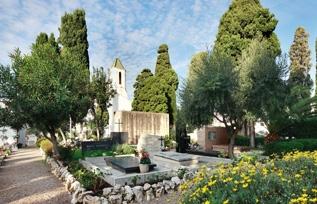Two tours of the cemeteries in Sitges and Vilanova explore the monumental graves of the 'americanos'

To commemorate All Saints' Day, Àltima is organizing two free guided tours to discover the history of the 'americanos' through the cemeteries:
- "The Artistic Soul of the Cemetery" in Vilanova i la Geltrú
- "The Souls' Route": History and Poetry at the Sant Sebastià Cemetery in Sitges
Activities: Two guided tours of the cemeteries in Vilanova i la Geltrú and Sant Sebastià in Sitges will provide insights into the 'americanos' through their monumental graves and mausoleums. The routes will reveal the tombs of several prominent figures from Garraf, created by renowned architects and sculptors from the late 19th and early 20th centuries. Additionally, the Sitges tour will include a reading of poems by authors such as Salvador Espriu, Joan Maragall, Jaume Carreres i Carreres, Jacint Verdaguer, and Pere Quart, among others, related to absence and loss.
Organized by: Àltima
Date:
- Sunday, October 27:
- “The Artistic Soul of the Cemetery” (Municipal Cemetery of Vilanova i la Geltrú)
- “The Souls' Route” (Municipal Cemetery of Sant Sebastià, Sitges)
Time: 12:00 to 13:30
Meeting Point: Main entrance of the cemetery.
Addresses:
- Municipal Cemetery of Vilanova i la Geltrú: Crta de Vilafranca s/n
- Municipal Cemetery of Sant Sebastià, Sitges: Av. Balmins s/n
Price: Both visits are free. Prior registration is required at the following numbers:
- “The Artistic Soul of the Cemetery” (Vilanova): 619 337 584 (Tessel·la)
- “The Souls' Route” (Sitges): 619 793 199 (Agisitges)
- Registration Deadline:** Saturday, October 26.
October 2013 - On the Sunday before All Saints' Day, Àltima is organizing two free guided tours that will explore the history of the 'americanos' through their tombs and mausoleums in two of the most monumental cemeteries in Garraf: Vilanova i la Geltrú and Sant Sebastià in Sitges.
Vilanova i la Geltrú and “The Artistic Soul of the Cemetery”
The tour “The Artistic Soul of the Cemetery” will visit the graves of some of the most famous figures in Garraf's capital, buried in this cemetery which began operating in 1855. Examples include writers like Víctor Balaguer and Manuel de Cabanyes, painter Joaquim Mir, and politician and businessman Francesc Gumà, who was involved in various railway and banking businesses in the mid-19th and early 20th centuries. Some of these graves are the work of important architects of the time such as Bonaventura Pollés and Domènech Estapà.
Sitges and “The Souls' Route”
On the other hand, “The Souls' Route” will take place at the Municipal Cemetery of Sant Sebastià, inaugurated in 1814, where the graves are true works of art from Catalan Modernism. These tombs belong to the 'americanos' or 'indianos,' families who left for the Americas in the 19th century to make their fortune. In this regard, the route through Sant Sebastià will uncover one of the most significant funerary monumental heritages of that era and into the early 20th century, with works by sculptors like Josep Llimona, Frederic Marès, Manuel Fuxà, Agapit Vallmitjana, Alexandre Mariotti, and Pere Jou, among other renowned architects. The tour will also highlight, in addition to the 'americanos,' other illustrious figures from Sitges buried in the same municipality. This year, the tour of Sant Sebastià Cemetery will include a reading of poems on loss and in memory of the deceased, which attendees who wish to do so can recite, by authors such as Salvador Espriu, Joan Maragall, Jaume Carreres i Carreres, Jacint Verdaguer, and Pere Quart, among others.
Vilanova and Sant Sebastià: Two Cemeteries of Cultural and Artistic Interest
Due to their artistic and architectural heritage, the cemeteries of Vilanova i la Geltrú and Sitges—both inaugurated in the first half of the 19th century—are part of ASCE (Association of Significant Cemeteries in Europe), a European association grouping over 150 culturally and historically significant cemeteries across the continent.
Both centers provide a valuable testament to Modernism in Garraf. During a time when various families from this region went to the Americas to do business and make their fortune (hence the term 'americanos' or 'indianos'), upon returning from the New World, they not only had majestic houses built but also tombs and mausoleums that matched their status. Today, one can still admire genuine works of funerary art from that period, created by sculptors and architects like Josep Llimona, Domènech Estapà, and Frederic Marès, some of the most prestigious of the time.